
Water Desk Grantee Publication
This story was supported by the Water Desk’s grants program.
Sunlight tunneled into the room and danced with smoke from Ed Johnson’s cigarette. He sat thinking of his mother.
In 2013, he moved back to the two-bedroom home in Hasty, on the southeastern plains of Colorado, to take care of her. Johnson, 62, remained in the house after her death in 2016.
The home is located at the entrance of John Martin Reservoir in Bent County. The town has a small general store, a post office, a bait shop and a campground that hosts guests visiting the reservoir mostly in the summer months. Several homes, similar in size to Johnson’s, are gridded along blocks of dirt roads that make up the township.
In the 1940s, the Arkansas River was dammed south of town to build the reservoir, a place locals call the Sapphire on the Plains. The reservoir was tied up in a 40-year battle until Colorado and Kansas came to an agreement, in 2019, to provide an additional water source to help keep the levels high enough for recreation and to support fish.
Forty years may seem like a long time to develop a plan to save fish and improve water levels for a reservoir, but southeastern Colorado is used to long fights when it comes to water.
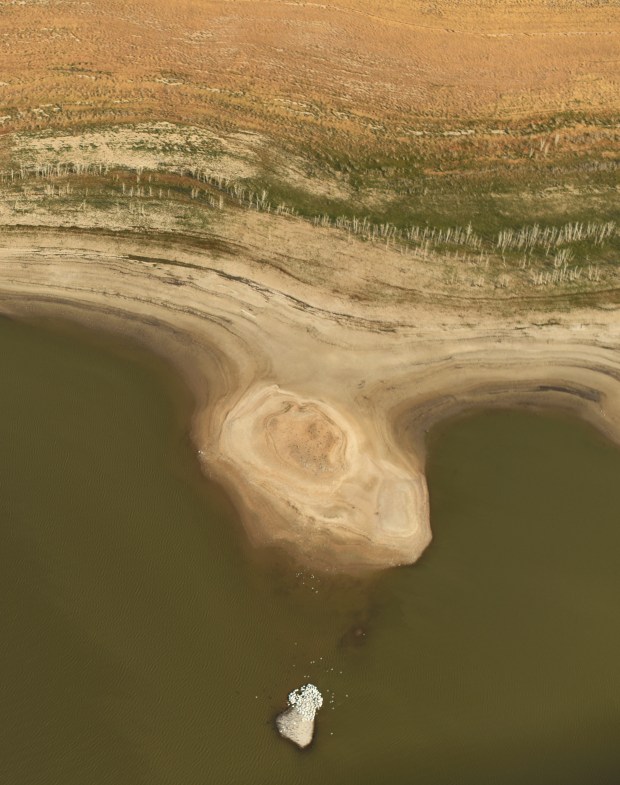
For nearly a century, leaders in southeastern Colorado have worked on plans to bring clean drinking water to the area through the proposed Arkansas Valley Conduit, but progress on the pipeline project stalled after a major push in the 1960s. Pollution, water transfers and years of worsening drought amid a warming climate continue to build stress for water systems in the area. Adding to that, the area continues to see population decline combined with a struggling economy.
The water needed for the conduit will be sourced from melting snowpack in the Mosquito and Sawatch mountain ranges. Under the Fryingpan-Arkansas Project Act, passed in the early 1960s, the water has been allocated for usage in the Lower Arkansas Valley. The water will be stored at Pueblo Reservoir and travel through existing infrastructure to east Pueblo near the airport. From there, the conduit will tie into nearly 230 miles of pipeline to feed water to 40 communities in need.
Renewed plans to build a pipeline to deliver clean drinking water to the Lower Arkansas Valley are bringing hope for many people in southeastern Colorado. But in an area that is inextricably linked to its water, the future can seem unclear.
One thing that was crystal clear were Johnson’s plans for the next morning.
“I am hightailing it out of here,” he said.
His black sedan was parked outside, and his belongings were piled past the windows. In the morning, he planned to start driving to South Carolina. “I’m gonna move in with my brother,” he said.
Johnson said he is not leaving because of the water issues in the area, even though the water has been bad as long as he could remember.
“It tastes like there is sweat in it,” he said. “That is nothing new. No, I’m leaving because this place is just plain hard.”
Hasty can feel like one of those places where time stopped. “You stand outside the post office, and you hear the same people say the same things,” Johnson said. For him, that was the hardest part of living there.

“Always talk and never action,” he said.
“Look at this dirt. You know how many times I heard them say they were going to pave the roads (in Hasty)?”
Johnson figured the plans to fix the drinking water were the same. Just talk with no action, and, for him, he’d had enough. Hasty, and its 144 residents, are now minus one.
“Deliver on that promise”
“It was nearly 100 years ago, in the 1930s, that the residents of southeast Colorado recognized that the water quality in the lower valley of the Arkansas River was quite poor,” said Bill Long, president of the Southeastern Colorado Water Conservancy District and a former Bent County commissioner.
Water systems in the district, which includes Pueblo, Crowley, Bent, Prowers, Kiowa and Otero counties, have two main issues affecting drinking water.
The first is that a majority of those systems rely on alluvial groundwater, which can have a high level of dissolved solids. This can include selenium, sulfate, manganese and uranium, which are linked to human health concerns.
Second, the remaining systems in the water district rely on the Dakota-Cheyenne bedrock aquifer that can be affected by naturally occurring radionuclides. Radium and other radionuclides in the underlying geologic rock formation can dissolve into the water table and then be present in drinking water wells, also carrying health risks.
In 1962, residents in southeastern Colorado thought President John F. Kennedy was delivering a solution to their drinking water problem during a ceremony in Pueblo. Congress had passed the Fryingpan-Arkansas Project Act, and Kennedy came to Pueblo to authorize the construction of a pipeline to deliver clean drinking water.
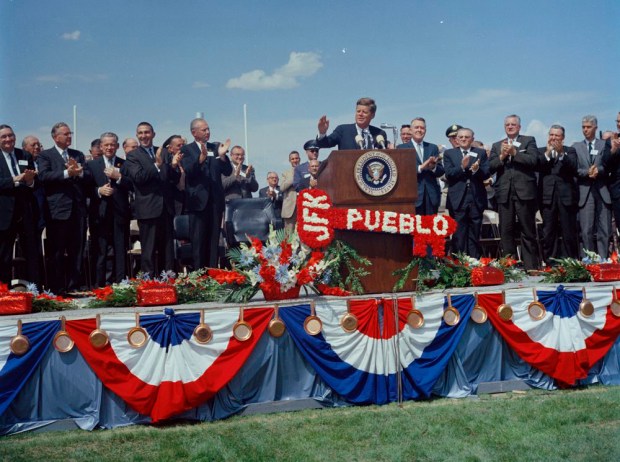
Kennedy said, “I hope that those of us who hold positions of public responsibility in 1962 are as far-seeing about the needs of this country in 1982 and 1992 as those men and women were 30 years ago who began to make this project possible. The world may have been built in seven days, but this project was built in 30 years.”
Residents of the 1930s began working on ideas to deliver clean drinking water to southeastern Colorado. By the 1950s, they were selling gold frying pans to raise money to send backers to Washington, D.C., to encourage Congress to pass the Fryingpan-Arkansas Project Act. But it wasn’t until 1962 that the pipeline authorization became a reality.
Fast forward 58 years, and two more politicians came to Pueblo to address a crowd about the same pipeline project. This time, on Oct. 3, 2020, it was at the base of Pueblo Dam. Because of funding shortfalls, the Arkansas Valley Conduit was never built after it was authorized in 1962.
The Colorado communities could not afford to cover 100% of the costs, as initially required, so in 2009, the act was amended to include a 65% federal share and a 35% local cost share. Additionally, in 2020, Congress appropriated $28 million more toward the project, according to the water conservancy district.
That October day, Sens. Michael Bennet and Cory Gardner took turns talking about the importance of the project. They told a small crowd that when the pipeline is built, it will provide clean drinking water to 50,000 residents in southeastern Colorado.

With dignitaries beside them, the two senators drove shiny new shovels into dirt to mark the day the Arkansas Valley Conduit construction began.
“In 1962, President Kennedy came to Pueblo, Colorado, and promised that we would build the Arkansas Valley Conduit. Here we are in 2020, and we’re beginning construction for the first time to actually deliver on that promise,” Gardner said.
The water conservancy district estimates the pipeline project’s cost will range from $546 million to $610 million.
“This is important to those 40 communities. They can no longer afford to treat their drinking water,” Gardner said.
Bennet said, “We got an important decision to make in this country about whether we’re gonna have a rural America or not. You can’t have a rural America if you don’t have clean water.”
In a statement, the Bureau of Reclamation said “a reliable source of clean, safe water is needed for the area’s health and welfare.”
Physical construction of the pipeline won’t start until 2022, according to the water district.
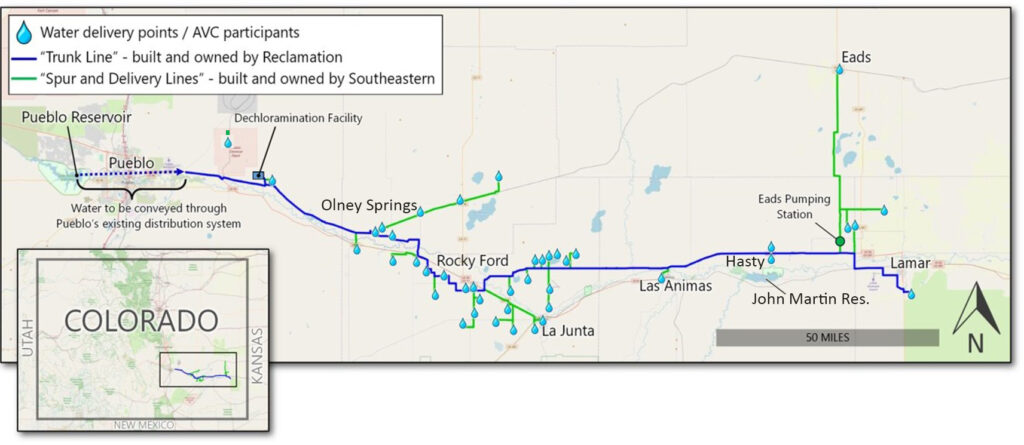
“They are the ones with the knowledge”
“Uncle Frank was a big shot on the Fryingpan project. He met Kennedy when he came to Pueblo,” said Steve Milenski, referring to JFK’s visit in 1962.
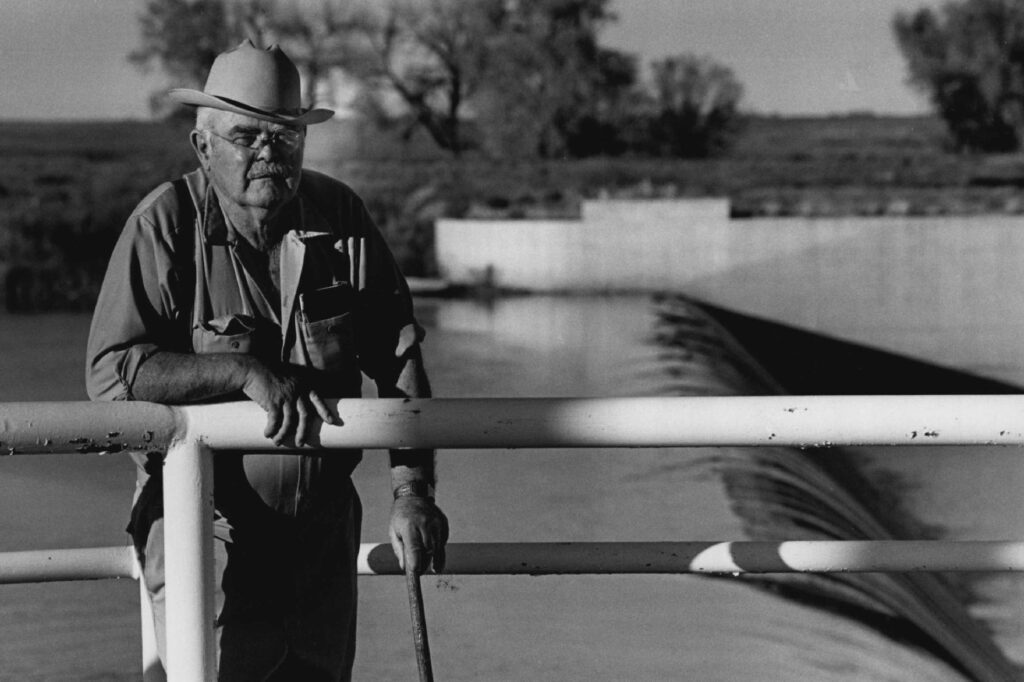
Milenski’s wife, Sandy, helped him maneuver his electric wheelchair into place at the dining room table before taking a seat next to him. The Milenskis talked about their family’s long history with water, and both took moments during the conversation to peer out of a window from their red brick ranch-style home near Las Animas, in Bent County.
Milenski was a longtime cowboy who grew up in Rocky Ford and was in the area most of his life. At 74 years old, he was living with Parkinson’s disease.
With help from his wife and friends, Milenski wrote down stories about working at a feedlot in Rocky Ford and about being a cowboy. They were stories he wanted to pass down.
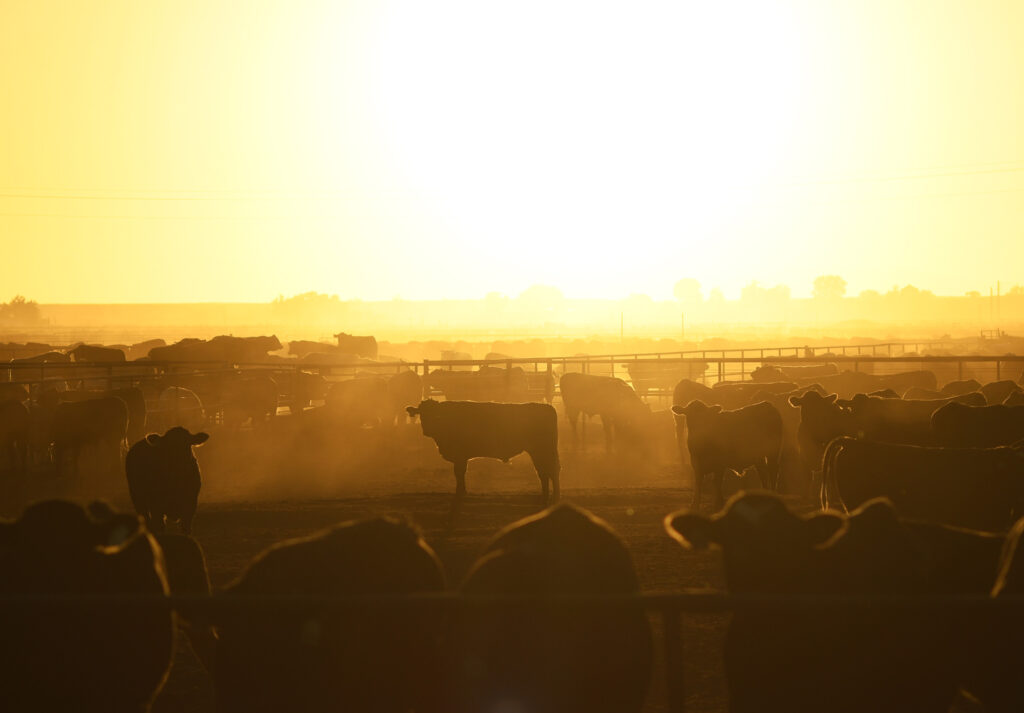
“In 1964, I got out of high school and drifted into the real world of digging post holes, driving trucks and breaking horses,” he wrote in one of the stories. He talked about learning to drive at 8 years old while helping his father feed cattle.
In another story, he wrote about the pain he had from Parkinson’s. “My personal belief is that pain and Parkinson’s disease go hand and hand with each other,” he wrote.
Milenski served during the Vietnam War in 1967 and ‘68. It was one of only a few times he was away from the Arkansas Valley, he said.
Milenski believed that his Parkinson’s was a result of his time in the Vietnam War, but still he and his wife wondered if his exposure to groundwater in the Arkansas Valley also played a part.
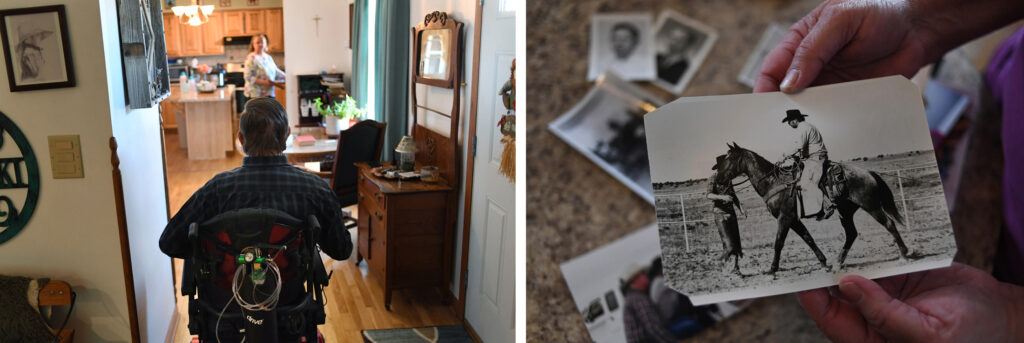
“It worries me a lot. It’s starting to show up in people’s health,” Sandy said, referring to the groundwater.
Milenski, a man who liked telling stories from his past, began to tell one about hunting turtle doves when he was a young man. He recalled telling the same story to his son. It was a memory about hunting near Rocky Ford, cleaning and dressing the birds in an irrigation ditch, and cooking them over a campfire. “You can’t do that anymore. The ditch is full of chemicals,” he told his son.
The irony that people in the area who work in agriculture are not able to return home to clean drinking water was not lost to Milenski. He emphasized that many people in agriculture deal with water on a daily basis as part of their livelihood. “They know more about water than most water managers,” he said.
“You have to give the freedom back to the farmers. They are the ones with the knowledge,” Milenski said.
Milenski died at home on Jan. 20, leaving his family with the stories he wrote down. He dedicated the handmade book filled with his stories and poems to his children. In a passage he wrote to Sandy, he said: “Two people are automatically admitted to heaven: a cowboy for putting up with all the weather and nature’s spiteful ways, and his wife for putting up with him.”
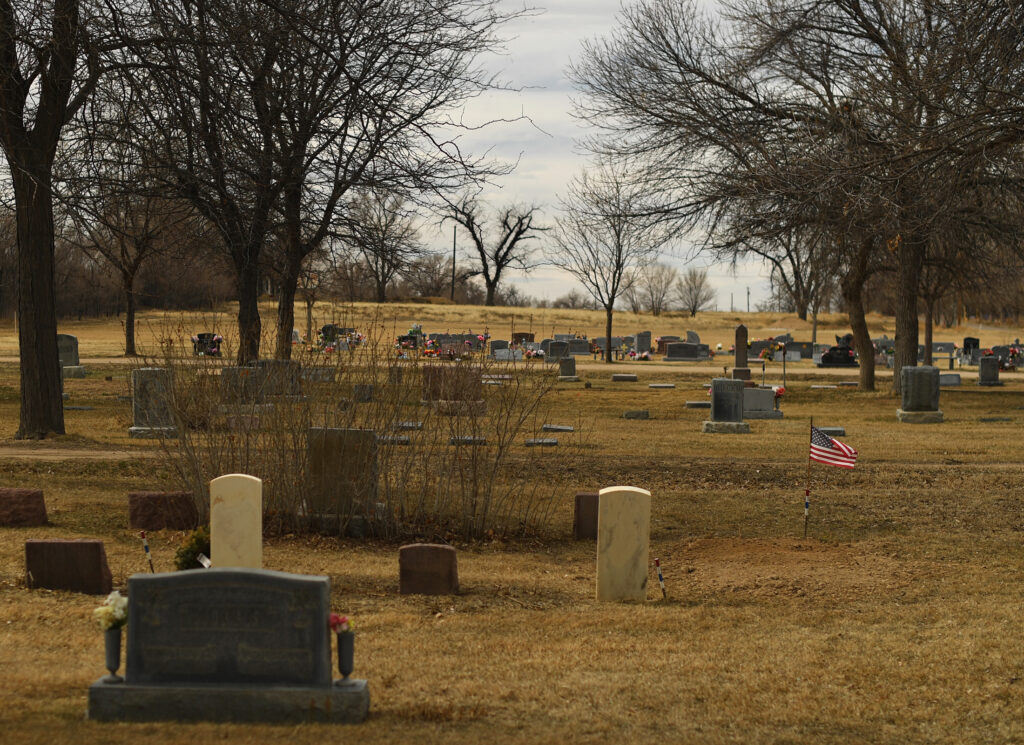
“They wanted the water”
“We’ve had enough,” said Roger Wilson. Somehow, they just knew the timing was right, he said. Wilson and his three brothers decided to auction off their parents’ farm in Olney Springs.
The auction list included 40 acres of farmland, the three-bedroom house, several outbuildings, tractors, tools, 40 shares of irrigation water from the Colorado Canal, and another 40 shares from Lake Meredith Reservoir.
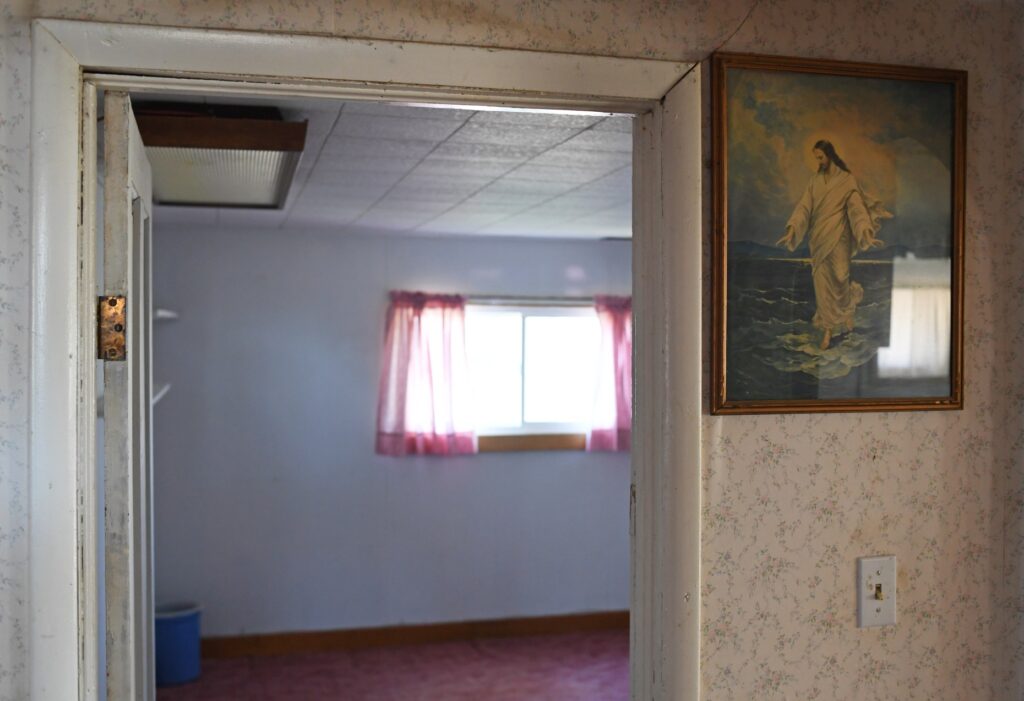
“My dad must’ve had a separate set of wrenches for every piece of farm equipment he owned,” Wilson joked as he sorted five-gallon buckets full of his father’s tools while they got ready for the auction. Sockets went in one bucket, while open-ended wrenches went into another.

“Everything sold,” Wilson later said. “Crowley County Water Association bought the house, the farmland and everything on it. They wanted the water.”
He wasn’t sure what the association’s managers planned to do with the home or the farmland, but he guessed they would hold onto the water rights until the time came when they really needed it. Crowley County has sold much of its water to the city of Aurora for municipal use.
Wilson said most of the town showed up for the auction. Things like that become big news in small towns like Olney Springs.
Doug Kenney, director of the Western Water Policy Program at the University of Colorado Boulder, said when a farmer has to downsize, for whatever reason, there are big consequences.
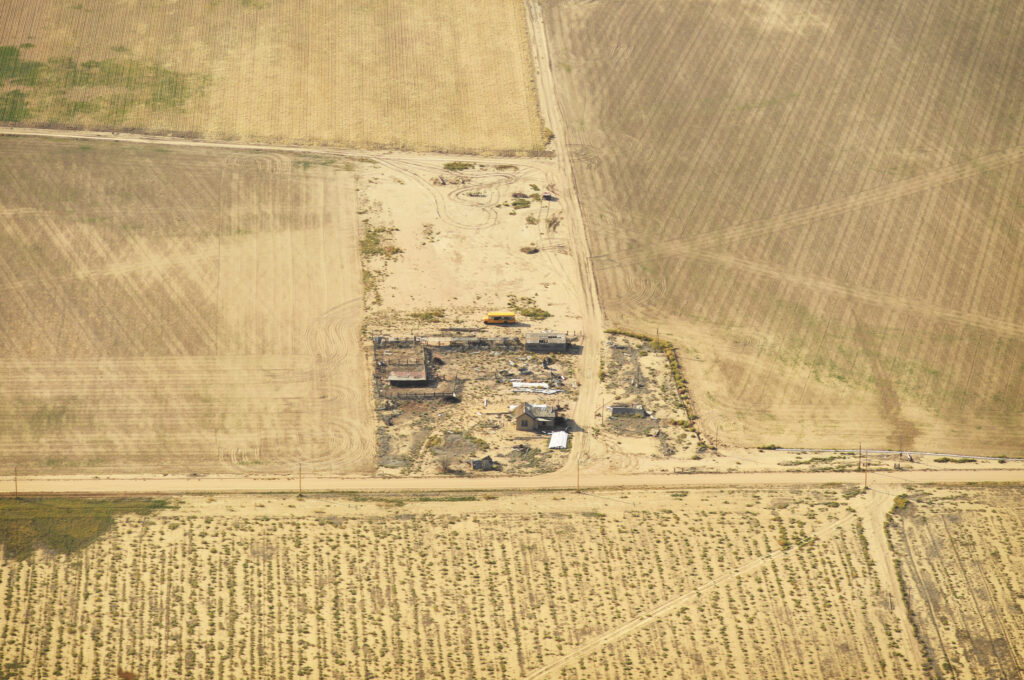
If a rural community sees water sold off voluntarily by farmers who no longer find the lifestyle viable, that can be “a real problem for all those that depend on the jobs, revenues and even the cultural identity that comes with living in a farm town,” Kenney said.

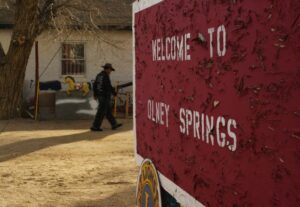
“The solution to pollution Is dilution”
A hand-painted sign with stenciled letters welcomes travelers on Highway 96 into Olney Springs. The highway cuts across four blocks that make up the width of the small town with around 340 residents.
Olney Springs is one of six water systems in Crowley County that plans to have a delivery point, known as a spur, on the Arkansas Valley Conduit. The plans for the pipeline call for two spurs in Pueblo County, three in both Bent and Prowers counties, and one in Kiowa County. Out of the 40 total participants, the remaining 25 are in Otero County.
Located along the Arkansas River about 70 miles east of Pueblo, La Junta is the largest municipality in Otero County. With its population around 7,000 and a Walmart Supercenter, a Holiday Inn Express and Sonic Drive-In, La Junta can feel like a metropolis when compared to Olney Springs.
La Junta is one of two Arkansas Valley Conduit participants, along with Las Animas, that uses reverse osmosis to remove potentially harmful and naturally occurring toxins from the water. Reverse osmosis is a process that uses pressure to push water through a membrane to remove contaminants. According to the Department of the Interior and the Bureau of Reclamation’s Arkansas Valley Conduit Environmental Impact Statement, reverse osmosis can treat source water to meet standards, but the brine from the process “is an environmental concern, and operation costs are high.”
AVC PROJECT PARTICIPANTS
Story continues below table
Pueblo County
Boone
Avondale
Crowley County
96 Pipeline Company
Crowley County Water Association
Town of Crowley
Town of Olney Springs
Town of Ordway
Town of Sugar City
Bent County
Hasty Water Company
City of Las Animas
McClave Water Association
Prowers County
City of Lamar
May Valley Water Association
Town of Wiley
Kiowa County
Town of Eads
Otero County
Beehive Water Association
Bents Fort Water Company
Town of Cheraw
East End Water Association
Eureka Water Company
Fayette Water Association
Town of Fowler
Hancock Inc.
Hilltop Water Company
Holbrook Center Soft Water Association
Homestead Improvement Association
City of La Junta
Town of Manzanola
Newdale-Grand Valley Water Company
North Holbrook Water
Patterson Valley Water Company
Riverside Water Company
City of Rocky Ford
South Side Water Association
South Swink Water Company
Town of Swink
Valley Water Company
Vroman Water Company
West Grand Valley Water
West Holbrook Water
Source: Southeastern Colorado Water Conservancy District
The other participants use conventional methods to treat water. The environmental impact statement said those methods can be as simple as adding chlorine for disinfection and filtration or adding chemicals to remove suspended solids, but that those treatments “…cannot remove salt or radionuclides from water.”
Tom Seaba, director of water and wastewater for La Junta, said out of a total of 24 water districts in Otero County, 19 were in violation with the state due to elevated levels of radionuclide.
Four of the 19 came into compliance with the state’s drinking water standards after La Junta brought them onto its water system. The remaining 15 are still in violation with the state, according to Seaba.
La Junta spent $18.5 million to build a wastewater treatment plant that came online in 2019 to help meet water standards for its community. But the city’s water treatment came with its own issue: selenium.
After La Junta treats its water using reverse osmosis, the water system is left with a concentrate, which is safe drinking water. However, it’s also left with a waste stream high in selenium. “That wastewater has to go somewhere,” Seaba said. It goes to the city’s new wastewater treatment plant.

“Same city, different department, same problem,” said Seaba, explaining how the waste now becomes a problem for the treatment plant. “They’re the ones that will end up taking the hit for a high selenium content being discharged into the King Arroyo (stream) first and then into the Arkansas River.”
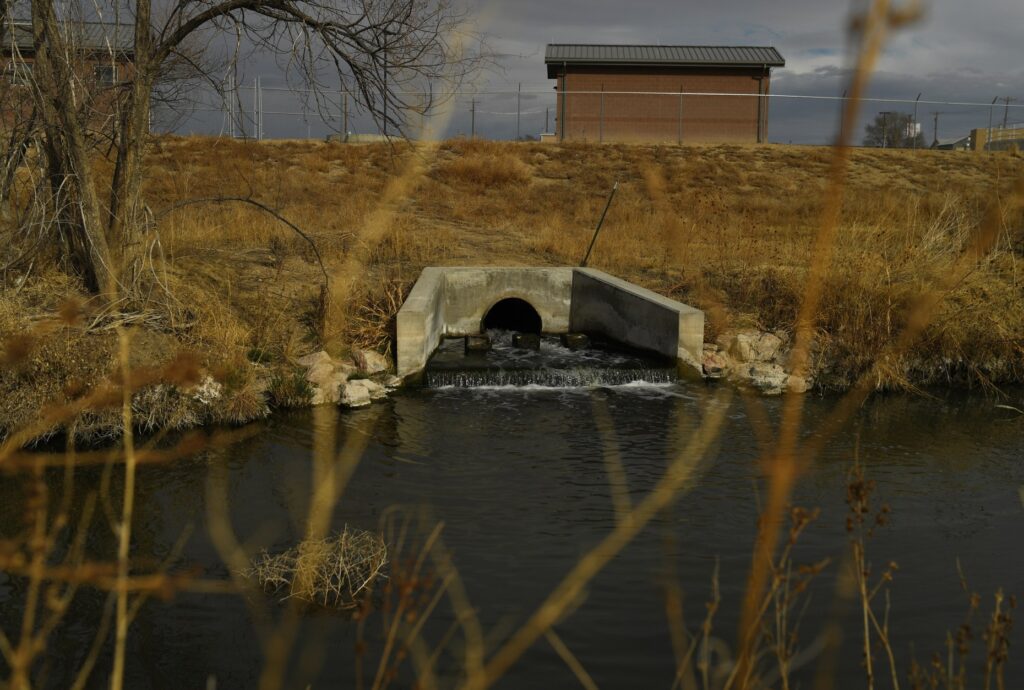
According to the environmental impact statement, “La Junta’s wastewater discharge makes up about 1.5% of average annual flow in the Arkansas River.” The study goes on to say that during drought or low-flow events, the wastewater discharge can contribute up to half of the streamflow downstream from the gage.
Seaba is looking to the Arkansas Valley Conduit as a possible answer. “The solution to pollution is dilution,” he said. The water from the pipeline will not have a selenium problem, Seaba explained. By blending water from the conduit with the selenium waste from reverse osmosis, La Junta hopes to reduce costs and stay compliant with Environmental Protection Agency standards to discharge into the river.
The environmental review studied a section of the Arkansas River from where Fountain Creek runs into the river east to the Kansas border. The study found that a section of the river was impaired by selenium. “High amounts of selenium and other metals are toxic to fish. High levels of selenium can also result in human health problems,” the report noted.
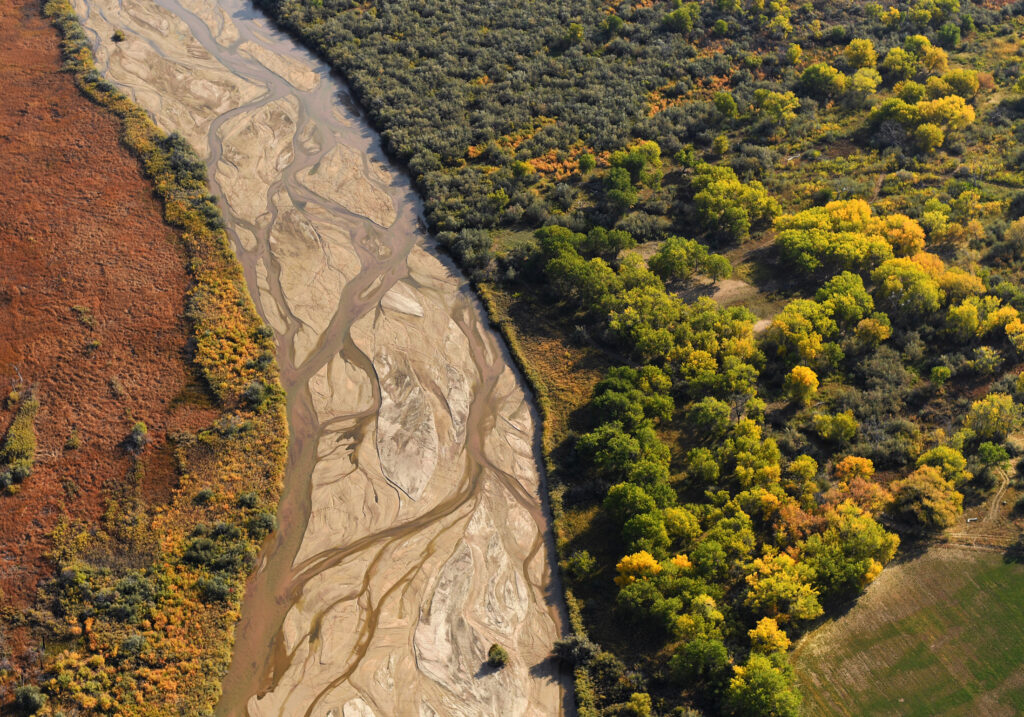
Seaba said “the expectation of systems to discharge water that is several times lower than what is naturally occurring can be frustrating and also exceptionally expensive. That cost can be a very difficult burden for citizens and systems that are in a recognized, economically depressed area.”
“I sure don’t drink it”
The EPA sets a maximum contaminant level in drinking water at 5 picocuries per liter of air for combined radium and 30 micrograms per liter for combined uranium. If contaminant levels are above those numbers, the water system is in violation of drinking water regulations, which the state enforces.
According to data provided by the Colorado Department of Public Health and Environment, the Patterson Valley Water Company in Otero County, one of the 40 pipeline participants, had the highest result of 31 picocuries per liter for combined radium in 2020. In that same county, Rocky Ford, another pipeline participant, had a high result of 0.2 picocuries per liter for combined radium. According to the state health department, Rocky Ford’s combined radium sample numbers were last recorded in 2013.

Manzanola, also in Otero County and a pipeline participant, topped the list with the highest result of 42 micrograms per liter for combined uranium in 2020. In contrast, 19 other pipeline participants, from across the valley, had results of 0 micrograms per liter for combined uranium, according to the most recent numbers from the state health department.
Levels of the two carcinogens are sporadic throughout the valley. The average of the highest results of all 40 participants in the pipeline for combined radium is roughly 8 picocuries per liter and combined uranium is roughly 5 micrograms per liter. According to Seaba, averaging the members’ highest results might seem unfair to some individual water systems because it brings their numbers up, but what those averages do show is that water in Pueblo Reservoir, which will feed the future conduit, is approximately three times less affected by combined radium and combined uranium than the average of current water used by pipeline participants. In 2020, the highest result of combined radium in the Pueblo Reservoir was 2.52 picocuries per liter, and the highest result of combined uranium was 1.7 micrograms per liter.
The EPA warns that long exposure to carcinogens like radium and uranium can lead to an increased risk of cancer, along with other health issues.

“I sure don’t drink it,” said Manny Rodriquez. “I don’t think anybody in town drinks the water.”
Rodriquez, who grew up in and still lives in Rocky Ford, was not sure if the water at his apartment was in violation of the state’s clean drinking water act or not. State data showed at that time his water was not in violation. Colorado is required to notify residents if their water system is in violation of the clean drinking water act.
Rodriquez watched as his girlfriend Shasta Nieto gave the couple’s 3-week-old baby Jakobe a bath in the kitchen sink at Rodriquez’s apartment.

“(In the shower), sometimes I look up and wonder what is spraying on me,” he said. While Rodriquez buys bottled water for his family to drink, he said they have no option but to bathe with the tap water.
It can be hard for residents to keep track of it all. Especially in Otero County, where at the start of 2021, the county had 421 outstanding water violations listed on the state health department’s website.
MaryAnn Nason, a spokesperson for the Colorado Department of Public Health and Environment, used an example to show how violations can add up: “If a public water system has two entry points that fail for both combined radium and gross alpha (measures of radionuclides), and they have those same violations for 10 years each quarter, that is going to appear as 160 violations on the website. But really, it is one naturally occurring situation that exists for a relatively long time,” Nason said.
For some residents like Ruby Lucero, 83, it makes little difference to her if her water is in violation with the state or not. She plans to buy her drinking water no matter what the results say about her tap water.
Lucero opened her change purse and pulled out exactly $2.80. She knew the amount well. It is what she spends every week filling up eight one-gallon bottles of clean drinking water at a water fill-up station outside of Rocky Ford Food Market.
“I’ve been doing this for over 20 years,” she said. For Lucero, buying clean drinking water has become just part of normal life living in Rocky Ford.
The environmental impact statement said, “The largest increase in median dissolved-uranium concentrations occurs between Rocky Ford and La Junta, where it more than doubles.” The statement goes on to say the probabilities of exceeding the primary drinking water standard for uranium in groundwater are high in counties like Otero.
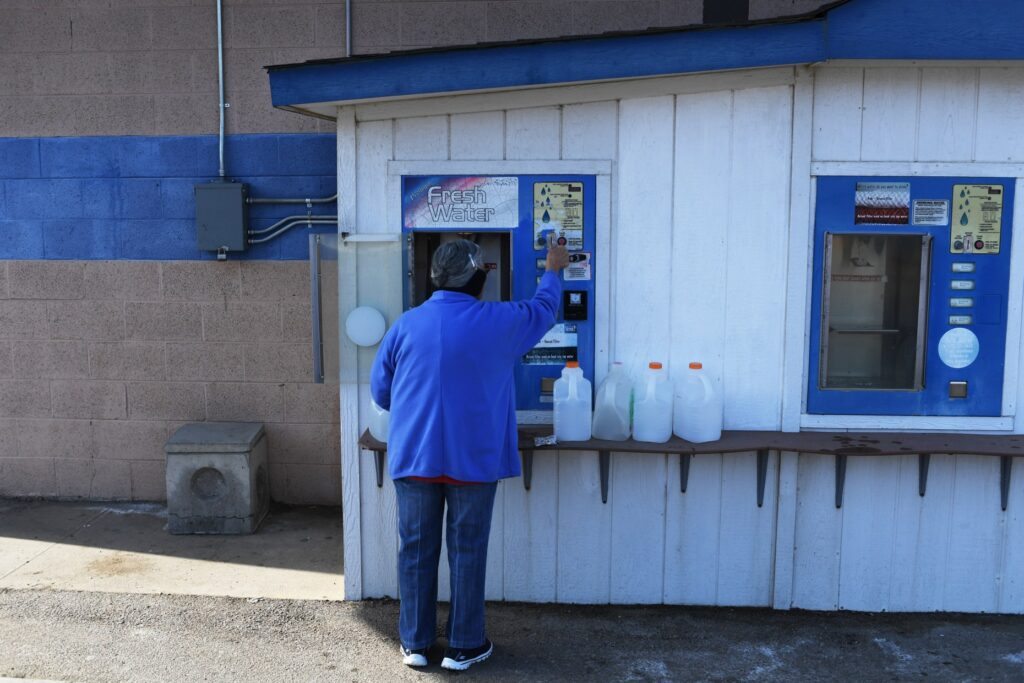
“The struggling farmer”
In the past decade, Otero County has seen a 2.9% drop in population. Residents have a ballpark difference of $38,000 in the median household income compared to the rest of the state, and the county is not alone. All six counties that are part of current plans for the Arkansas Valley Conduit are seeing economic hard times.
Adding to those factors is drought. Years of drought keep hitting the area’s No. 1 industry: agriculture.

Glenn Hirakata, a fourth-generation farmer in Otero County, knows all too well the effect drought is having on his family’s farm. Hirakata and his cousin Michael co-own Hirakata Farms in Rocky Ford, where they are known for growing mostly melons. During the season, the farm has between 80 and 100 employees.
“We have basically one shot every year to make a crop,” Hirakata said.
But drought has made that one shot harder.
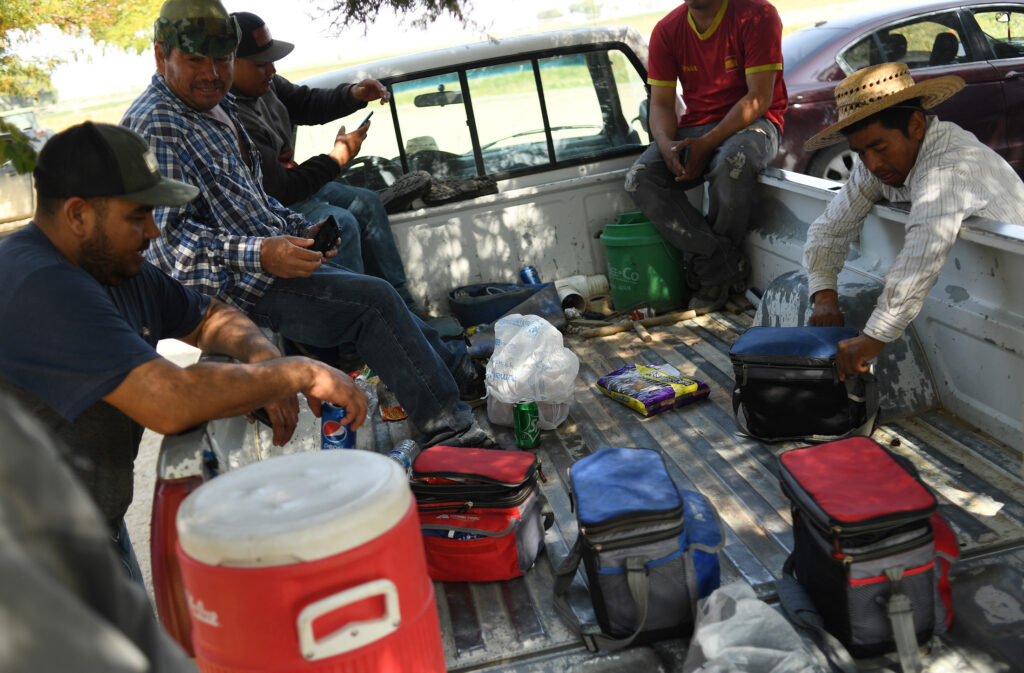
“You can plan out everything, how you wanted it to go, but as you see the water situation dwindle, you have to make adjustments. It will keep you up at night,” he said. “As the snowpack dwindles and the runoff starts to slow down, you’ll start losing your irrigation water. Your crops will start burning up. Why put money into a crop, and then just let it fail? You have to make a decision. We ended up leaving some ground open, not planting every acre.”
In 2020, the cousins made a decision not to plant on 30% of their available land due to drought.
Looking out his truck window at land where nothing was planted, Hirakata said, “We’ve lost water at an earlier stage than normal. We are all out of water right now.”
From the truck, you could see rows of empty dirt going east to west as far as the eye could see. Hirakata said a year before, near the same time, the field was full of watermelons.

“As far as the agriculture and the farming side, the (pipeline) project doesn’t have a lot of effect on us. It mostly helps municipalities, but I’m not sure if I’ll ever see it finished in my lifetime,” he said.
The Arkansas Valley Conduit project falls fairly low on the long list of things Hirakata thinks about when it comes to water on the farm. The proximity of Rocky Ford Ditch, which runs near Hirakata Farms, acts as a constant reminder of what is high on his list.
“The ditch down here below us sold off to Aurora,” he said.
The Rocky Ford Ditch’s water rights date back to 1874, making them some of the most senior water rights in the Arkansas River system. In the early 1980s, Aurora was able to buy a majority of those water rights. Over time, Aurora acquired more shares and has converted them to municipal use.
“It’s not if it’s going to happen, it’s when. The Front Range keeps growing and growing, and the pressure for water grows with it. Who will they go to? They will go to the struggling farmer,” Hirakata said.

“Little bites of an apple”
From a ridge at Kevin Karney’s ranch in southern Otero County, you can see all the way into New Mexico.
At the ranch, Karney tucked himself tight up to a fence as a strong wind blew from the west. A mixture of dust and wind caused his eyes to water while he watched one of his heifers give birth. Karney said it was moments like that when he knows he is doing things right.

The former Otero County commissioner and current chairman of the Arkansas Valley Conduit committee for the Southeastern Colorado Water Conservancy District is passionate about agriculture being the cornerstone of southeastern Colorado.
The fourth-generation rancher, and water manager, has been fighting to keep water from being transferred out of agriculture. Recently, he opposed the transfer of water from the Fort Lyon Ditch to Colorado Springs Utilities. Fort Lyon Ditch, nearly 100 miles long, is the largest ditch in the state, and Colorado Springs, one of the largest communities in Colorado, wants the ditch’s water to support its growing municipality.
“Take little bites of an apple. Cumulatively, over time, it’s gone,” Karney said.
The cumulative effect of these water transfers has Karney worried that over time, there may be little water left for agriculture in rural Colorado.

The future in the Lower Arkansas River Valley is also worrisome to water experts like Doug Kenney.
“In a region where water is scarce, water issues are typically a zero-sum game,” said Kenney, director of the Western Water Policy Program. “Those with power — either financial, political or legal — will prevail over those without.
“Over the last 50 years, one of the biggest issues has been the transfer of water out of agriculture into municipal uses, which raises all sorts of socioeconomic issues that the water management rules are poorly equipped to deal with. In an era of water scarcity, it’s about competition, and it’s about winners and losers,” Kenney said.
Back on the ranch, Karney worries those transfers can lead to more “buy and dry scenarios” for the Lower Arkansas River basin. When water is bought and transferred out of an area and leaves it dry, agriculture loses, he said. Without agriculture, Karney feels that rural populations will continue to dwindle, and there may be few people remaining to benefit from the pipeline project.

“We in rural (southeastern Colorado) don’t depend on Amazon. We depend on each other,” he said. The rancher hopes the benefits of the pipeline are not lost. “The conduit is important to us as ag producers because it supports our municipalities. Our services are there — our gas stations, our hospitals, our schools and grocery stores,” Karney said.
He is positive that the pipeline project is more than a pipe dream. Unlike Hirakata, who questioned whether the conduit will be finished in his lifetime, Karney believes the project will be finished according to plans, which call for completion in a 15-year period. Thirty million dollars will need to be appropriated each year during those 15 years.
“We still have a heavy lift before us”
Planned off the main trunk of the Arkansas Valley Conduit, a pump station near Wiley will push water along a spur to support Eads in Kiowa County. Water that ends up in Eads will have traveled the longest distance of the pipeline project. The majority of the pipeline will be gravity-fed, but this section will need to be pumped uphill.

The journey is a good representation of Eads’ battle with water. Not only is clean drinking water needed, but the area is also desperate for relief from years of drought exacerbated by climate change.
When looking at the U.S. Drought Monitor map at the start of 2021, Eads is easy to spot. On the map, a dark circle surrounds the town. The circle is shaded a burnt red color, representing exceptional drought condition — the highest level. Exceptional drought is defined by the U.S. Drought Monitor as an area seeing dust storms, widespread topsoil removal and high agricultural and recreational economic losses.
“These folks are so stoic,” said Dawn Beck, a physician’s assistant at Eads Rural Health Clinic who grew up in a ranching family in rural Colorado. “Their entire livelihood is based on outcomes that they really have no control over.”
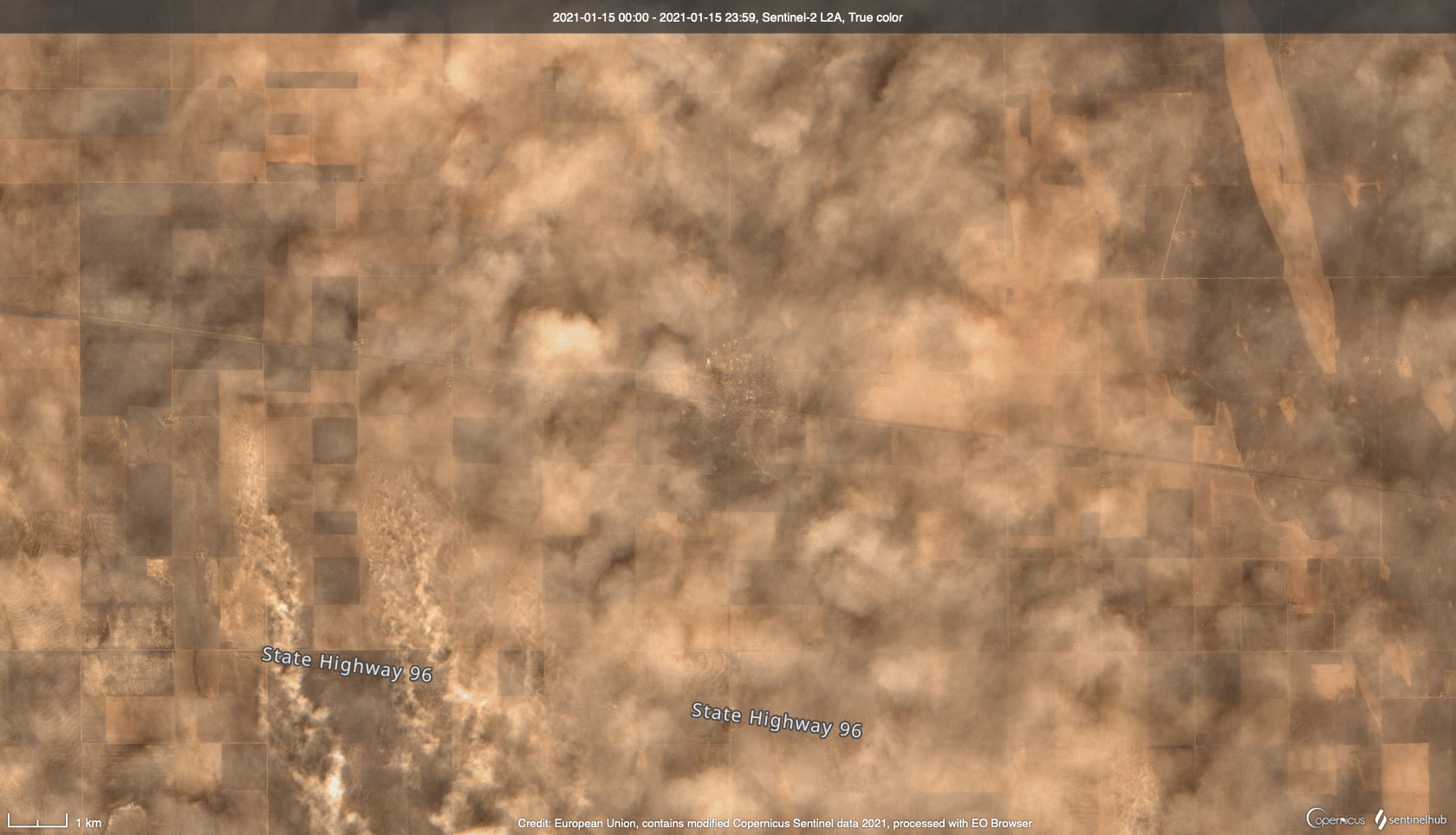
If patients talk about their mental health, Beck just listens. She said they have a cowboy mentality.
“You can see it in their eyes and in their behaviors,” she said. “They went through a drought before. They will get through this again. They are very resilient. They are able to pick themselves up, brush themselves off and move forward. They don’t dwell on things. They really do think positive about the future.”
It is a positive future that Long, president of water conservancy district, hopes the pipeline will help ensure for communities like Eads in rural Colorado.

Long said that Eads is different from a majority of the other participants in the project because it is not located along the Arkansas River.
“Their opportunities are even fewer than those opportunities that may exist in communities along the river,” he said. “There’s no irrigation right out of the river.”
The domestic water that will be delivered via the conduit is even more important for a town like Eads, said Long. “It’s very difficult to attract new industry when you have a limited supply of very poor water.”
Long believes the conduit will make a huge difference to support communities in the Lower Arkansas River Valley.

“Economic development and future growth are extremely difficult with the current water supply,” Long said. “If you don’t have good water, you don’t have much of anything.”
Long has been working on the Arkansas Valley Conduit project for nearly 18 years.
“After such a long fight, to finally be where we are feels good, but honestly I can say it doesn’t feel as good as I thought it would. Only because I know we have so much work still to do, and I know how difficult the past 18 years have been,” Long said. “We still have a heavy lift before us.”
This story originally appeared in The Denver Post on June 27, 2021.
Longform Story CSS Block


